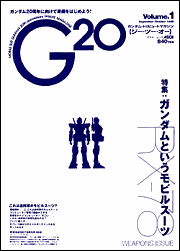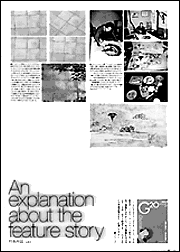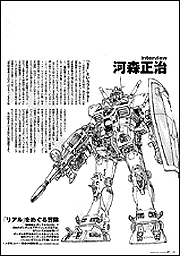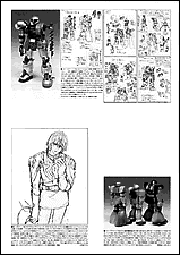




|
 |


—by Egan Loo
Some anime series celebrate their anniversaries with an LD box set and
maybe a spinoff video. GUNDAM celebrates the big 2-0 with LD boxes, a new television
series, a live-action special, and its own magazine. The LD
boxes of the first GUNDAM series may be out of reach for most fans of this
space warfare classic, but fortunately G20, the "MOBILE SUIT GUNDAM 20th ANNIVERSARY TRIBUTE MAGAZINE," provides a
less-expensive surrogate.
 For now, ASCII is planning only nine bimonthly
issues from August 1998 to December 1999 for G20 (pronounced
"Gee-two-oh,"). The eighteen-month run neatly encapsulates all the Gundam Big
Bang highlights from last summer's Gundam Big Bang Proclamation event to the
television debuts of the "Gundam A Project" and G-SAVIOUR.
(The tentatively titled "Gundam A Project" marks the return of original
GUNDAM
creator Tomino Yoshiyuki, while G-SAVIOUR pools the efforts
of the Japanese studio Sunrise with the American computer graphics company
Polestar Group.) For now, ASCII is planning only nine bimonthly
issues from August 1998 to December 1999 for G20 (pronounced
"Gee-two-oh,"). The eighteen-month run neatly encapsulates all the Gundam Big
Bang highlights from last summer's Gundam Big Bang Proclamation event to the
television debuts of the "Gundam A Project" and G-SAVIOUR.
(The tentatively titled "Gundam A Project" marks the return of original
GUNDAM
creator Tomino Yoshiyuki, while G-SAVIOUR pools the efforts
of the Japanese studio Sunrise with the American computer graphics company
Polestar Group.)
 Each issue will have a special feature; the first issue's focus is
"The Mobile Suit Named Gundam," while the later issues will cover "Zeon—the
Chosen Nation," "Newtype," and so forth. Here, various experts wax rhapsodic
about any subject including space colonies, real-life parallels to GUNDAM
technologies, and the Zeon's manifest destiny. The essays are heavy reading, but
not any more satisfying than those in B-CLUB or CINEJIN. Each issue will have a special feature; the first issue's focus is
"The Mobile Suit Named Gundam," while the later issues will cover "Zeon—the
Chosen Nation," "Newtype," and so forth. Here, various experts wax rhapsodic
about any subject including space colonies, real-life parallels to GUNDAM
technologies, and the Zeon's manifest destiny. The essays are heavy reading, but
not any more satisfying than those in B-CLUB or CINEJIN.
 Nevertheless, the best essay in the first issue is easily Iizuka
Masao's recollections on GUNDAM's genesis (as told to Mizutani Tatsuhiko). Ever
wonder how Sunrise discovered Robert Heinlein's STARSHIP
TROOPERS novel and his influential powered suits? The book was brought
to the attention of Sunrise's head by a certain science-fiction fan named Takachiho
Haruka—co-founder of Studio Nue and author of CRUSHER JOE
and DIRTY PAIR. Nevertheless, the best essay in the first issue is easily Iizuka
Masao's recollections on GUNDAM's genesis (as told to Mizutani Tatsuhiko). Ever
wonder how Sunrise discovered Robert Heinlein's STARSHIP
TROOPERS novel and his influential powered suits? The book was brought
to the attention of Sunrise's head by a certain science-fiction fan named Takachiho
Haruka—co-founder of Studio Nue and author of CRUSHER JOE
and DIRTY PAIR.
 Ever wonder where the name Gundam came from? Initially, the creators
tried to symbolize a gun-toting robot piloted by a youth by combining "gun"
with "boy." When "Gunboy" failed to pass the muster of good taste, they tried
combining "gun" with "dom" (as in "freedom"). One problem: Tomino didn't
like how "Gundom" looked when written in bold logo letters. Hmmm .... "dam"
sounds similar, and dams protects fields from floods—just like a robot
protecting Earth .... Without further ado or fanfare, "Gundam" was born. Ever wonder where the name Gundam came from? Initially, the creators
tried to symbolize a gun-toting robot piloted by a youth by combining "gun"
with "boy." When "Gunboy" failed to pass the muster of good taste, they tried
combining "gun" with "dom" (as in "freedom"). One problem: Tomino didn't
like how "Gundom" looked when written in bold logo letters. Hmmm .... "dam"
sounds similar, and dams protects fields from floods—just like a robot
protecting Earth .... Without further ado or fanfare, "Gundam" was born.
 The other essays are not all quite so illuminating. Their quality
ranges from expert commentaries on the Gundam mythos to the self-portrait of
a cross-dressing Gundam "girl." (Don't ask.) The other essays are not all quite so illuminating. Their quality
ranges from expert commentaries on the Gundam mythos to the self-portrait of
a cross-dressing Gundam "girl." (Don't ask.)
 Of more interest in the first issue are interviews with four
GUNDAM
mecha designers: Ohkawara Kunioh (first GUNDAM, VOTOMS), Kawamori Shouji (GUNDAM 0083,
MACROSS), Izubuchi Yutaka (GUNDAM: CHAR'S
COUNTERATTACK, PATLABOR), and Katoki Hajime (V GUNDAM, VIRTUAL ON). In these
interviews, we find out how Ohkawara was brought over from Tatsunoko (of GATCHAMAN fame) to the then upstart Sunrise studio, and why
Kawamori insists on being credited for only "mecha styling" instead of the
standard mecha design credits. Of more interest in the first issue are interviews with four
GUNDAM
mecha designers: Ohkawara Kunioh (first GUNDAM, VOTOMS), Kawamori Shouji (GUNDAM 0083,
MACROSS), Izubuchi Yutaka (GUNDAM: CHAR'S
COUNTERATTACK, PATLABOR), and Katoki Hajime (V GUNDAM, VIRTUAL ON). In these
interviews, we find out how Ohkawara was brought over from Tatsunoko (of GATCHAMAN fame) to the then upstart Sunrise studio, and why
Kawamori insists on being credited for only "mecha styling" instead of the
standard mecha design credits.
 Each issues also includes nuggets that only a
GUNDAM enthusiast
could enjoy, such as a two-month calendar combining real historical dates,
GUNDAM chronological events, and
GUNDAM release info. It won't make for good
cocktail conversation, but isn't it nice to know that the Soviets launched
Sputnik 1 on the same day in 1957 that Garma Zabi dies and GUNDAM
ZZ episode 31 aired in UC 0079 and AD 1986 respectively? Each issues also includes nuggets that only a
GUNDAM enthusiast
could enjoy, such as a two-month calendar combining real historical dates,
GUNDAM chronological events, and
GUNDAM release info. It won't make for good
cocktail conversation, but isn't it nice to know that the Soviets launched
Sputnik 1 on the same day in 1957 that Garma Zabi dies and GUNDAM
ZZ episode 31 aired in UC 0079 and AD 1986 respectively?
 Another regular feature is "Gundam Tourist," a page devoted to the
prominent locale in the GUNDAM lore. In the first issue, see Sydney as it
stands today, as it crumbles in the colony drop in 0079, and as it remains in
the resulting crater circa 0083. Another regular feature is "Gundam Tourist," a page devoted to the
prominent locale in the GUNDAM lore. In the first issue, see Sydney as it
stands today, as it crumbles in the colony drop in 0079, and as it remains in
the resulting crater circa 0083.
 Finally, each issue will cover special events and merchandising.
For example first issue covered Big Bang event with a write-up and even an
tongue-in-cheek cartoon (Syd Mead: "I just got here from Hollywood."
Tomino: "Anno will not beat me!!"). It also included a pictorial essay of
every Bandai RX-78 model ever made (including 0080
and 0083 variants) before the Perfect Grade release. Finally, each issue will cover special events and merchandising.
For example first issue covered Big Bang event with a write-up and even an
tongue-in-cheek cartoon (Syd Mead: "I just got here from Hollywood."
Tomino: "Anno will not beat me!!"). It also included a pictorial essay of
every Bandai RX-78 model ever made (including 0080
and 0083 variants) before the Perfect Grade release.
 There is one surprising omission in G20 so
far: not one interview or even a blurb from Tomino himself. Anyone hoping
G20 would be the mouthpiece for Tomino's musings and
rants will be disappointed. Still, Tomino has been very tight-lipped about
actual story specifics on his new projects in other magazines, so perhaps
this is not a big loss. There is one surprising omission in G20 so
far: not one interview or even a blurb from Tomino himself. Anyone hoping
G20 would be the mouthpiece for Tomino's musings and
rants will be disappointed. Still, Tomino has been very tight-lipped about
actual story specifics on his new projects in other magazines, so perhaps
this is not a big loss.
 With its relatively few color pages and long navel-contemplating
essays, G20 is not for those expecting something similar
to the graphic-intensive Hobby Japan or Newtype. It is, however, an interesting
read with enough gems of information to make it a valuable resource in a
Gundam fan's library. With its relatively few color pages and long navel-contemplating
essays, G20 is not for those expecting something similar
to the graphic-intensive Hobby Japan or Newtype. It is, however, an interesting
read with enough gems of information to make it a valuable resource in a
Gundam fan's library.
ASCII Corporation
72 pages (black & white and color)
Issue 1 (The Mobile Suit Named Gundam) August 1998, ISBN4-7561-1860-7
Issue 2 (Zeon—The Chosen Nation) September 1998
Issue 3 (Newtype) January 1999
¥840 (tax included)
Where to buy |


